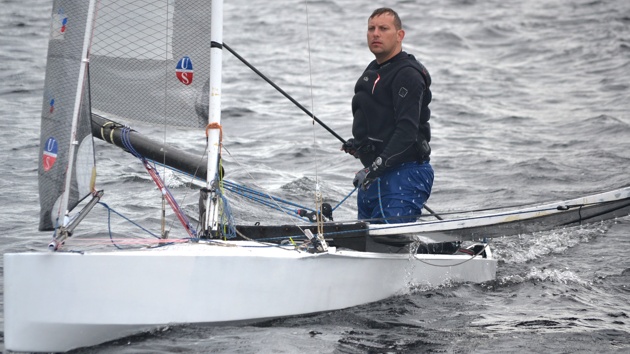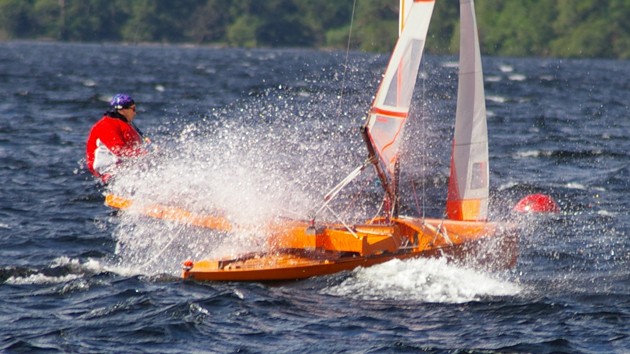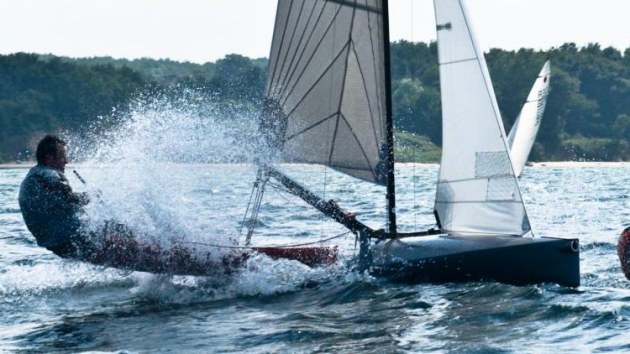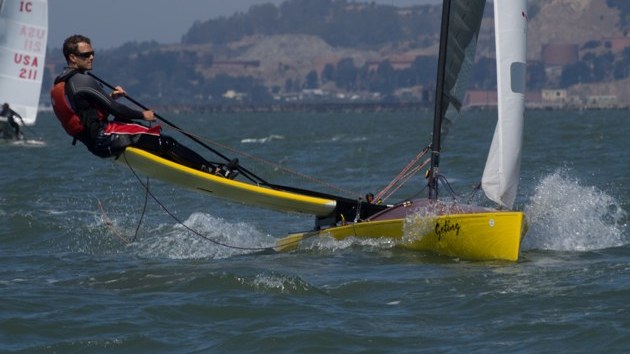The Decked Canoe Archives
Assembled by Tim Gittins
The Modern Sailing Canoe
She Offers the Keenest Sailing Pleasures to Yachtsmen With Acrobatic Agility and a Sensitive Touch
By Irwin W. Tyson
Originally printed in "Yachting", July 1949
Imagine, if you can, a 17-foot boat that will sail at 16 knots and one that you can watch from a distance of five feet while you sail her. Imagine yourself taking a full capsize, getting your boat up again and under full way in just 30 seconds without a drop of water in her bilge. And, if you are interested in design, imagine a boat of 450 pounds displacement putting a 900-pound stress on her weather shroud - a boat whose center of gravity may sometimes be a good two feet outboard of her weather rail!
Had you visited City Island last Labor Day weekend you would have seen a dozen such craft - decked sailing canoes we call them - competing for the National Championship of the American Canoe Association. Just two weeks earlier, many of this same group were 300 miles north, in the Thousand Islands, sailing a series for the Canoe Association's Challenge Trophy, which has been in continuous competition since 1886. Meanwhile, in England, two American canoes were seeking to wrest from the British the 63 year old New York Canoe Club International Challenge Cup which Uffa Fox and Roger DeQuincey captured in 1933 for the Royal Canoe Club. For the sailing of decked canoes is a sport of international as well as national traditions.
To understand just what a decked sailing canoe is, and why it is distinctively different from all other types of craft, one must go back to 1892 and a man named Paul Butler, for it was this one genius who introduced all four of the 'gimmicks' that really define the type.
Prior to Butler's time, sailing canoes actually looked much like canoes, 15 or 16 feet long, half-decked, with modest rigs, usually consisting of batswing main and mizzen. Butler, seeking to overcome the disadvantage of his scant 110-pound weight, devised first the thwartships sliding seat to give that weight greater leverage, then the thwartships crosshead tiller so he could steer while out on the end of his seat, and next the automatic cleat to tend his sheets until he came in. By this time he had such a fast outfit that prudence dictated a self-bailing cockpit to keep the seas out of her. During the ensuing half century rigs have changed, rules have been rewritten and hull forms altered, but Butler's four innovations, the hiking seat, the crosshead tiller, automatic cleat, and self-bailing cockpit are to this day the distinguishing features of the decked canoe. Together they form the combination that accounts for the sensational speed of these boats. Their value can be gauged by the fact that our conservative British cousins have adopted all but the crosshead tiller in less than 60 years! Which would be a much better joke if they hadn't walked off with the International Cup the first time they tried the hiking seat. That was in 1933 and it marked the beginning of the sailing canoeists 'modern era.'
Between 1888 and 1933 there had been no competition between England and the United States. As a result, the British and American rules had diverged so widely that the design of a boat to fit both rules required drawing board acrobatics that would have defied the imagination of anyone but Uffa Fox. The boats which he and Roger DeQuincey brought to our shores in 1933 made us gasp for they resembled our canoes as the sand barge resembles the rowing shell. We could capsize one of our canoes by leaning to one side as we sat in it, while the Limeys could pace their decks with hands in pockets. We carried 34-inch sheet aluminum centerboards while they dragged cast bronze drop-keels that a man could scarcely lift. We carried the old main and mizzen rig; they were sloops and 'horror of horrors' they had no trick cleats, no crosshead tillers, and no self-bailing cockpits. To see Uffa gaily singing his way around the course with mainsheet and tiller in one hand and bailing scoop keeping cadence with the other was heart-warming. But it was heart-rending to see Uffa and Roger depart for England encumbered with all our favorite trophies.
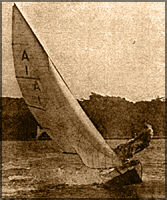
Uffa Fox's two-seater canoe has the shorter hiking seats characteristic of most British sailing canoes. (photo: Beken)
The result was an international rule, adopted in 1935, a masterpiece of compromise under which we took their sloop rig and they took our hiking seat, with a host of lesser concessions by both sides.
The following year, Gordon Douglass, sailing for Canada, challenged for the New York Canoe Club Trophy with Nymph II, a canoe with the traditional fine-lined American hull surmounted by a rather heavy sloop rig. Nymph went home with her tail between her legs, and her skipper with a set of plans under his arm - the plans of Wake, the canoe that beat him. Shortly thereafter, Douglass went in business as a boatbuilder and soon gave birth to a half dozen or more new, canoes, all strictly on the British type, broad and flat with sloop rigs held aloft by a maze of piano wire. One of them he sailed to the A.C.A. Championship before turning to the building of 14-footers and Thistles.
Meanwhile, others had been fitting sloop rigs to some of the hulls designed in the late twenties bv Hilding Froling, unquestionably our outstanding canoe designer of recent years. These Froling boats, while much finer lined than the British type, were larger than the more numerous '16-30s', being 17 feet over all with as much as 42 inches beam, with enough stability in their midship sections to keep them upright at anchor with no one aboard.
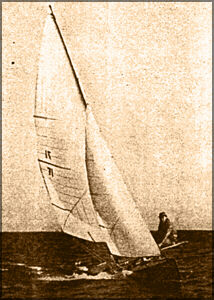
Lou Whitman's "Manana" planing in a moderate wind, is a happy blending of British and American hull types.
To see the flat Douglass hulls beside the sharp Froling hulls, one would never suppose they raced in the same class, yet the truth is that each type has won most of the principal trophies in this country at one time or another. All of which points up the fact that in light, unballasted boats sailing ability counts for far more than hull design and a hand on the tiller is worth two on the bankroll.
Under the International Rule, as modified slightly in 1947, a decked canoe may be from 16 to 17 feet long, with 37 3/8 to 43 1/4 inches beam, and her stripped hull may not weigh less than about 145 pounds (depending on dimensions). Actual sail area is measured and must not be over 10 square meters (107.64 square feet). There are limits on mast height and on centerboard depth and weight. The hiking seat may not extend more than 5 feet outboard.
Most of our canoes have been fitted with inverted-vee decks that drain into the centerboard trunk. All now race with a conservative sloop rig and it is interesting to note that even though actual sail area is measured, a slightly overlapping jib is universally used.
All sheets lead through automatic cleats which are so contrived that the sheet is automatically freed as it is trimmed in, then held fast by the cleat at the point to which it is trimmed. A touch of the toe on a small lever opens the cleat, letting the sheet run out until the lever is released. When the lever is pushed over a dead center, the cleat will remain open until closed.
The crosshead tiller is easier to make than to describe. The net effect of this contrivance is that when your rudder is amidships, your tiller, a light spar about 5 feet long, is exactly athwartships, extending outboard parallel to the hiking seat. This tiller is held loosely in a metal sleeve in the crosshead so that it can be slid outboard to windward as the hiking seat is extended.
To tack one of these canoes requires lightning execution of quite a complex routine. Luff - slide inboard along the hiking seat - kick open the weather jib sheet cleat (which controls the lee sheet) - lift your weight off the hiking seat and slide it across the boat - slide the tiller across - duck under the boom - snap shut the other jib sheet cleat - trim in the jib - slide out on the seat - and away you go! Or else.
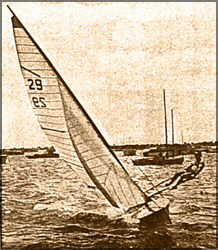
Joe Farrugia's "Damaris" has the fine lines typical of American canoes. They are at their best in strong winds.
Surprisingly enough, these canoes are not difficult to keep on their feet. Because of the long hiking seat, your weight can exert a tremendous leverage with none of the tummy-tautening exertion required of the crew of a dinghy. You wont be out at the end of your seat until the breeze gets up around 10 or 12 knots and the Stars, for example, will be spilling wind from their mainsails long before the canoes are. With your sheets held fast by the automatic cleats, you have only to steer with one hand and grasp the hiking seat with the other, 'one hand for yourself and one for the ship.'
Actually, the decked canoe is one of the safest boats you can sail. If you fall overboard, she will courteously capsize and wait for you to scramble back aboard. Because she is completely decked over, with hermetically sealed hatches, she cannot swamp unless holed, and even then the wood in her hull and gear will keep you afloat until help arrives. To right a capsized decked canoe, you simply stand on the centerboard, brace one foot on the bilge, heave out to windward and downward on the hiking seat, and clamber aboard as she comes up. Most sailors can do it in less than 30 seconds!
In only one respect is the sailing of a decked canoe fundamentally different from sailing most other craft. If overpowered on a reach you do not luff; you bear away. This is because your canoe, travelling at perhaps 12 knots in a 12 knot breeze, tends to double the apparent wind velocity as soon as she luffs, while by bearing off before it, she sharply reduces the apparent wind.
Right here is a good place to squelch any wild tales you may have heard concerning the canoe's speed. Uffa Fox does claim to have been clocked at better than 16 knots over a measured half mile under ideal conditions. And half mile seat reaching legs have been covered at better than 15 knots in more than one race in this country. But such speeds are rare. A check back over American Canoe Association racing records will reveal a good percentage of races completed at an average of better than 6 knots around a triangle and this, in turn, would indicate something like 12 knots on the reaches. Over a range of weather conditions, you are likely to find your canoe passed by the Stars in a zephyr, but walking past them once there is any weight in the wind. You are likely to have a close brush with an Atlantic in almost any weather, provided she does not lead you out into open water. For while a decked canoe can live in any sea, she will, like any other light boat, slow up badly the a real chop. Even then, however, the canoe has a big advantage for, by letting her heel slightly, your seat (as well as the canoes) will rise well above the crests of the seas, and your position out to windward keeps you well clear of spray.
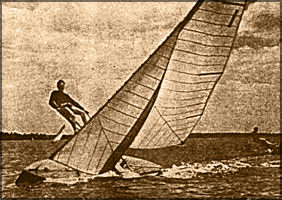
Another American type, Jesse Fishman's "Teal," takes a near knockdown. Canoes must be sailed on their feet.
At present, the writer knows of about 25 decked canoes that are actively in commission on the East Coast and there are at least that many more laid up in sound condition. The largest active fleet is on Eastchester Bay at City Island, N.Y., where eight or ten race on the average summer weekend. Another fleet is rapidly growing at Lindenhurst on Great South Bay. Rolf Armstrong, the noted illustrator, has the nucleus of another group started at Marblehead. A few other canoes are occasionally seen at scattered localities.
At present, the best way to break into the class is to pick up an existing hull and rig to ginger up as much as your skill and your purse permit. With these light boats, where so much depends on sailing ability, many an old wreck has in been brought to the top of the class. In 1948, for example, the national championship was won by a 20-year-old canoe.
Building presents some obstacles at present. Unquestionably there are several naval architects capable of designing you a successful canoe, or existing designs might be duplicated. Building of these light, highly specialized boats, however, requires skilled craftsmanship and you might have to shop around a bit before finding anyone capable or willing to do the job. When you have located a builder, don't be surprised if the cost is in the neighborhood of $2000.
Some decked sailing canoes are being turned out by amateur designer-builders but even though chine hulls and plywood construction are permitted, an extremely high degree of skill is required for the light constructions and special fittings that seem essential.
Governing body of the sport is the American Canoe Association and a letter, care of Yachting, addressed to the writer, Chairman of the Association's National Sailing Activities Committee, will bring information on the designs that are available, as well as where to look for used boats.
With the possibility of two canoes being sent to England this summer to avenge the close defeat suffered in 1948, keen oompetition is assured for this season. Yet it is unlikely that the class will ever grow really large for it takes an individualist, if not an egocentric, to enjoy the strenuous single-handed oompetition these light racing machines offer. Time after time, one-design classes have been proposed, only to go aground through lack of agreement.

The long hiking seat, crosshead tiller and automatic cleats are largely responsible for a canoe's high performance.
On the other hand, it is certain that the class will never die out, for no other type of boat can offer such keen pleasure. To fly at 12 knots, suspended a scant foot above the waves; to feel in your fingertips the vibrating pulse of this delicate craft that weighs little more than yourself; to sit out five feet from your boat and watch her leap through the seas; to see her centerboard flashing through the water; to feel her accelerate with each puff; or to glide wake-less and silently over glassy waters is to know the greatest beauties of the meeting of wind and water.
I apologize for the poor quality of the photos - they are scanned from a photocopy of the article - someday when time permits I will get down to the Reference Library and scan the original article.
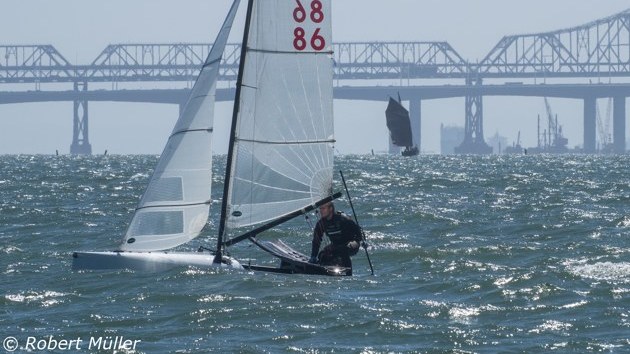
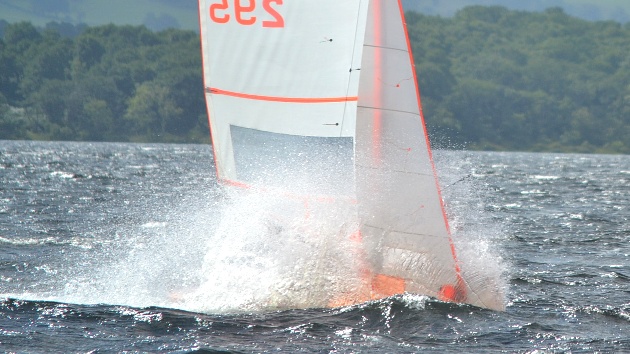
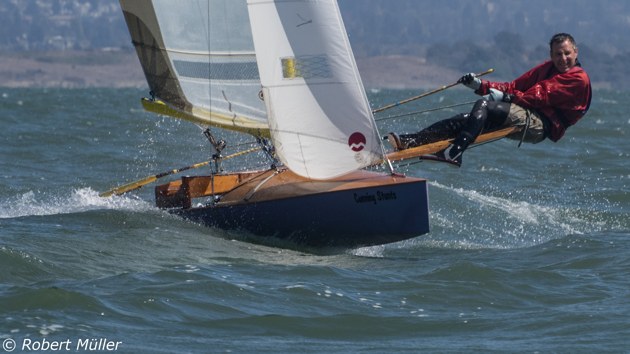
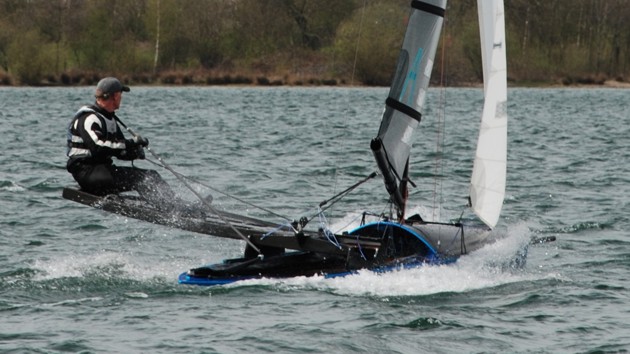



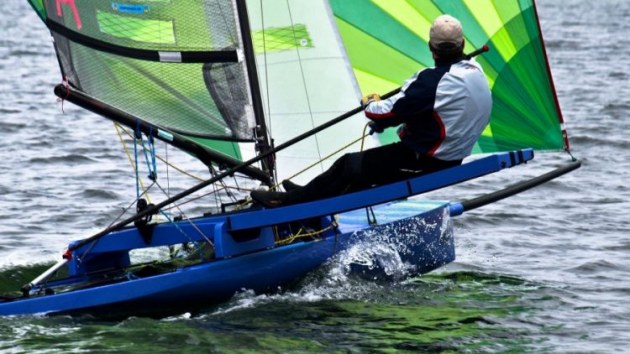
Ulrike_veerkamp.jpg)
Ulrike_veerkamp.jpg)
Ulrike_veerkamp.jpg)

